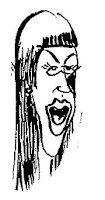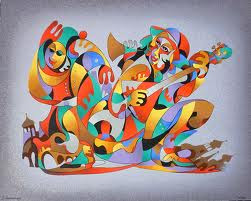This is the cast I combine and juxtapose to create a compelling narrative as students react/respond to Mr. Q's lectures. They are stand-ins, reading lines for whoever will play the future character. There is some jockeying and competition between these candidates; they each want the job. Staring in this graphic novel will be a great boon to their careers and fame. Final casting is still way off but I am impressed with the acting skills of these script readers.
MAIN CHARACTERS (non of which have proper names yet; they're identified by predominant trait)
ENTHUSIAST This student loves Mr. Q regardless of how obtuse or self contradictory the lectures are. He's a loyal Golden Retriever type, fawning to a fault.
ANXIETY DRIVEN. This poor soul is whipped back and forth by Mr. Q's doom and gloom. I'm not sure of her back story (yet?) but she's hyper sensitive to threats, risk, and danger. She lives in perpetual fear, hyper vigilant to all worst case scenarios, which is all of them.
JOKER. Every sit com needs a wise cracking quipster. He's only in the class for a grade; his highest value is being liked as class clown.
PRE-LAW. This fine actress engages Mr. Q in a protracted discussion about estate planning. She got so fed up with his lack of cooperation that she leaves in exasperation.
DOOFUS. Joker tells jokes. Doofus is outrageous in his silliness. He's a champion of lost causes, ignorant of his own ignorance, and zealous to absurd proportions.
SENSUALIST. He loves sex, pleasure, wine and cigars and vacations. He's not above snorting a snoot full when the opportunity arises, which isn't often enough in his mind.
VEGAN PSYCH MAJOR. I know I'm not supposed to have favorites, but this lover of co-ops, organic foods, social justice, and psychology with feather ear rings and facial piercings fascinates me. She's too prickly for any romantic interests but I love this woman's opinions...which she shares effortlessly.
SCIENTIFIC MATERIALIST. This guy has zero tolerance for superstition, faith, or god talk. He's irritated by religion and the many unverified claims Mr. Q makes. This guy is a skeptic, atheist, logical positivist, and brilliant. A necessary and important player in any philosophical discussion.
HIP HOP ARTIST. Don't think only bling or gold teeth define this guy. He's brilliant, pissed, creative, intolerant of any bullshit, and a welcome addition to discussions of social justice, economics, and racism. Keeping a lid on his potty mouth is my biggest challenge with this guy.
EPICUREAN. Any mention of food in this class (of which there are many) and Mr. Epicurean is there. He loves Mr. Q's frequent carpe deum statements, "Eat, drink, and be merry."
FOIL. Somebody's got to move the plot along without a joke, wise crack, or philosophical profundity. That's this guy's job. I also think he's going to play a significant role in the future somehow. Of all the characters he's the most reposed. By contrast the others appear reactionary, frantic, and on speed.
FEMINIST. Another one of my favorites. Like the Scientific Materialist this character has little patience with fanatics. She's also the watch dog for patriarchy, sexism, and gender inequality. When we get to later chapters she's going to justifiably flip out. Stay tuned.
MILITARIST. In college on the GI Bill, this guy loves guns, force, and military might. So far he's only played a minor role but in upcoming chapters he'll go bonkers with many of Mr. Q's dovish comments.
AGED HIPPIE. How can we discuss death-saturated Ecclesiastes without a fan of the Grateful Dead? The 60s glory days are behind him but he's not deterred. He's still fighting the Man, the plastic people, and the rising cost of dope.
TEACHER ASSISTANT. While not identified as such yet--I'm only to chapter 5:10 in rough draft 2 and this character's true identity has not yet become public among the students; they think he's just a brown noser--this character is necessary to clarify some of Mr. Q's more obtuse statements. He'll give the wrap-up lecture (Eccl. 12). I use him sparingly but he comes in very handy when I need to make sure readers understand (though not necessarily agree with) what Mr. Q is saying.
MATERIALIST. This marketing and business major loves money. Discussions of social justice, existentialism, and death are irrelevant to him since his highest ambition is becoming a multimillionaire before he's 30.
FUNDAMENTALIST. Ah yes, how can we forget this key player? Her enthusiasm for absolute Truth works against her because Mr. Q is a moving target. She glibly writes off any philosophy that contradicts the Bible, which is often in this class. Her emotional fervency and closed mindedness do not earn her a lot of friends in this class. She's okay with that, however, as she wears her persecution complex on her sleeve. I'm trying my hardest not to create a straw man with this character.....
ACTRESS. This is the first (of many) students to drop the class. Her passion is happiness and the tenor of this class is so morose she bailed in the first week. She switched majors and chose a new career guaranteed to bring endless bliss, acting.
PARTY GIRL. Tanning, Cancun, drama, and her dad's largess keep this gal going. "This class sucks but I need the credits," she whines. But like all these characters we don't know what she'll be thinking by the end of this class. I can't wait to see what happens.
























.gif)
.jpg)

























